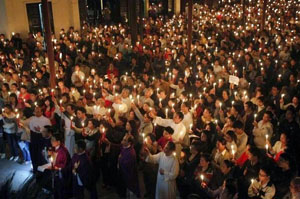by Luiz Sergio Solimeo

The face of modesty.
“I love vulgarity. Good taste is death, vulgarity is life." These words by English fashion designer Mary Quant, who took credit for inventing the miniskirt and hot pants, reveal one of the most important, though rarely pointed out, aspects of the “fashion revolution” that started in the sixties: vulgarity.
Indeed, fashions have increasingly tended toward vulgarity. It is a vulgarity that tramples upon not only good taste and decorum but which reflects a mentality opposed to all order and discipline and to every kind of restraint, be it esthetic, moral or social, and which ultimately suggests a completely “liberated” standard of behavior.
Are Comfort and Practicality Supreme Criteria?
The rationale for introducing ever shorter skirts was “to be practical and liberating, allowing women the ability to run for a bus.” The notion that comfort, practicality and freedom of movement must be the only criteria for dress has led to a breakdown in the general standard of sobriety and elegance, not to speak of the norms of modesty.
Thus, casual dress, being more comfortable and practical, increasingly becomes the norm regardless of people’s sex, age and circumstances. Jeans and the T-shirt (formerly a piece of underwear) became part of common attire.
Though one can wear less formal clothes at times of leisure, these clothes should not convey the impression that one is abandoning one’s dignity and seriousness. They should not give the idea that one is actually on vacation from one's principles.
In the past, even leisure dress, though more comfortable, maintained the dignity that one should never abandon.
It is curious to note that many companies require employees to wear business suits to convey an image of seriousness and responsibility. This is proof that clothes do transmit a message.
They can express seriousness and responsibility or on the other hand, immaturity and a carelessness.
Unisex Garb
The premise that comfort and practicality must preside over the choice of clothes had yet another consequence: clothes no longer reflect one's identity. In other words, they no longer indicate a person’s social position, profession, or even more fundamental characteristics such as sex and age.
Thus, unisex garb has become widespread: jeans and shorts have come to be worn by people of both sexes and all generations.
Young men and women, the youth and the aged, single and married, teachers and students, children and adults, all mix together and wear one and the same clothing which no longer expresses that which they are, think or desire.
 The Habit Does Not Make the Monk but Identifies Him
The Habit Does Not Make the Monk but Identifies Him
One could object that “the habit does not make the monk.” The fact that a person dresses with distinction and elegance does not mean, of itself, that he has good principles and good behavior. Likewise, the fact that a person always wears casual dress does not necessarily indicate that he has bad principles or a reprehensible conduct. At first sight, the argument appears logical and even obvious.
However, analyzed in depth, it does not stand.
True, the habit does not make the monk. Nevertheless, it is a strong element that identifies him. Furthermore, it influences not only the way people look at the monk but the way he looks at himself. No one will deny that the loss of identity by many nuns and monks that took place over the last forty years was largely due to their shedding the traditional habits, which adequately expressed the spirit of poverty, chastity and obedience, as well as an ascetic lifestyle proper to consecrated persons.
The Need for Coherence Between Dress and Convictions
Given the unity that exists in our tendencies, principles, convictions and behavior, the way we dress cannot fail to influence our mentality.
Wearing a certain type of clothing constitutes a form of behavior; and when clothing no longer adequately reflect our tendencies, principles and convictions, one’s mentality begins to undergo an imperceptible change to remain ‘in sync’ with the way one presents oneself. This is because human reason, by the force of logic inherent in it, naturally seeks to establish consistency between thought and behavior.
This rule is magnificently summed up in the famous phrase of French writer Paul Bourget: "One must live as one thinks, under pain of sooner or later ending up thinking as one has lived."
The process of transformation or erosion of principles can be slowed down or impeded by a person’s religious fervor, deeply rooted tendencies or ideas, and other factors. However, if inconsistency between behavior - reflected in the way one dresses - and one’s principles and convictions is not eliminated, the process of erosion, no matter how slow, becomes inexorable.

The beautiful, simple, and modest dress of the Belle Epoque.
Living Faith, Inadequate Clothing
This subtle erosion is often manifested by a loss of sensitivity regarding the fundamental points of one’s mentality. One example would be the respect one must have for the sacred.
In some way, concessions to the principle that comfort must be the only rule of dress have ended up by giving a casual note to more serious and holy activities. How can one explain, for example, that persons who have true faith in the Real Presence of Our Lord in the Blessed Sacrament, and who make admirable sacrifices to frequent perpetual adoration, nevertheless see no contradiction in presenting themselves before the Blessed Sacrament wearing shorts as if they were on a picnic?
The same person who shows up thus dressed for perpetual adoration would never don those clothes for an audience, say, with Queen Elizabeth II. This contradiction shows how, though the person has maintained his faith, to a certain degree the notion of the majesty of the Sacrament of the Altar -- the Real Presence -- has vanished from his soul.
Egalitarianism...
There is a general tendency in our times to establish a most radical egalitarianism at all levels of culture and social relations between the sexes, and even, in the tendency of egalitarianianism, between men and animals.
In dress, this egalitarianism is manifested by the growing proletarianization, the establishment of unisex fashions and the abolition of differences between generations. The same garb can be worn by anybody no matter his position, age or circumstance (e.g. in a trip, a religious or civil ceremony).
Chaos reigns in the domains of fashion today. It is often difficult to distinguish, by their clothes, men from women, parents from children, a religious ceremony from a picnic. Haircuts and hairstyles follow the same tendency to confound age and sex and to break down standards of elegance and good taste.
...That Leads to Infantilization
One of the aspects that stand out the most in the modern dictates of fashion is the desire to create an illusion of eternal youth, even perpetual adolescence with no responsibility, a phenomenon that has been called the “Peter Pan Syndrome."1
Modern fashion shows a tendency to infantilize people. A Brazilian fashion critic thus expressed herself: “For a long time now, we have seen on catwalks, both international and domestic, fashions that should be displayed at the Children’s Expo, such is the level of infantilization they suggest. Stylists over 25 years old were designing (and wearing) clothes that could be worn by children in a day care center.”
Modesty is Essential to Chastity
In addition to the extravagant, egalitarian and infantilizing tendency of modern fashion, one needs to consider the attack on virtue and the complete lack of modesty.
The human body has its beauty, and this beauty attracts us. Due to the disorder which Original Sin left in man, the disorder of concupiscence, the delight in contemplating bodily beauty, and particularly of the feminine body can lead to temptation and sin.
That is not to say that some parts of the body are good and can be shown and others are bad and must be covered. Such a statement is absurd and was never part of Church doctrine. All parts of the body are good, for the body is good as a whole, having been created by God. However, not all body parts are equal, and some excite the sexual appetite more than others. Thus, exposing those parts through semi-nudity or risqué low cut dresses or wearing clothes so tight as to accentuate one’s anatomy poses a grave risk of causing excitation, particularly in men in relation to women.
Therefore, clothes must cover that which must be covered and make stand out that which can be emphasized. To cover a woman’s face, like Muslims do, shows well the lack of equilibrium of a religion that does not understand true human dignity. The face, the noblest part of the body because it more perfectly reflects the spiritual soul, is precisely the part that stands out the most in the traditional habits of nuns.
Just as masculine clothes should emphasize the manly aspect proper to man, feminine fashion should manifest grace and delicacy. And in this sense, having longer hair is a natural adornment to frame a woman’s face.
Immorality in Fashions and Destruction of the Family
Garb that does not show a person’s self-respect as an intelligent and free being (and, through baptism, as a son or daughter of God and a temple of the Holy Ghost), contributes to a large extent to the present destruction of the family. It does this by favoring temptations against purity. It also does this by its vulgarity and childishness that corrodes the notion of the seriousness of life and the need for ascesis (self-discipline), all of which are fundamental elements that maintain family cohesion and stability.
The struggle for the restoration of the family by opposing abortion, contraception, and homosexuality will be much more effective if done together with efforts to restore sobriety, modesty and elegance in dress.
Dress and the Love of God
The role of clothing is not only to protect the body from the elements but also to serve as adornment and symbolize someone’s functions, characteristics and mentality. Garb must be not only dignified and decent but also as beautiful and elegant as possible (which requires more good taste than money).
If the “way of beauty” leads us to God by seeing Him as the exemplary cause of Creation, the “way of ugliness” turns us away from the Creator and places us on the slippery slope of sin. That is why ugliness is the very symbol of sin and is so well expressed by the expression “ugly as sin.”
_____________________
Footnotes:
- Mary Quant talks to Alison Adburgham, Tuesday, October 10, 1967, http://century.guardian.co.uk/1960-1969/Story/0,6051,106475,00.html.
- Cf., http://www.spiritus-temporis.com/mary-quant/
- Fortunately, for some time now there has been a wholesome reaction against the abandonment of the traditional habit, a fact that has brought an increase in the number of vocations. According to a recently published book, “communities of sisters whose members wear an identifiable religious habit” are the most flourishing and attract young women the most. (Book says young women attracted to orders whose members wear habits, CNS, http://www.catholicnews.com/data/briefs/cns/20090526.htm).
- Cf. Plinio Corrêa de Oliveira, Revolution and Counter-Revolution, http://www.tfp.org/index.php?option=com_content&task=view&id=691&Itemid=107.
- Cf. Dr. Dan Kiley, The Peter Pan Syndrome - Men Who Have Never Grown Up, Dodd, Mead & Company, New York, 1983.
- Gloria Kalil, Os kidults e a moda Alô Chics! http://chic.ig.com.br/site/secao.php?secao_id=1&materia_id=867.







 The Habit Does Not Make the Monk but Identifies Him
The Habit Does Not Make the Monk but Identifies Him 


 by Dustin Siggins
by Dustin Siggins 





 Dr. Chazan says he regards the fine and damage to his career as nothing more than “a ransom for the life of the child,” which he was happy to pay.
Dr. Chazan says he regards the fine and damage to his career as nothing more than “a ransom for the life of the child,” which he was happy to pay.  Hilary White
Hilary White